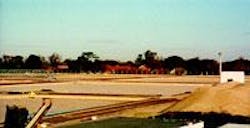Floating geomembrane covers curb algae growth
By Vincent McPartland
Floating covers, made from reinforced polypropylene geomembrane, helped to curtain algae growth in 18 filtration ponds that supply drinking water to an estimated 500,000 people in Essex, England. Essex and Suffolk Water is part of the company NWL, part of Ondeo Services UK plc, formerly the Northumbrian Water Group.
Each of the 18 rectangle-shaped sand filter beds holds approximately 186,000 cubic feet. Built in a grid pattern three across and six long, the concrete filter beds act as a secondary filter for water collected from a local river.
Water is piped into each of the 18 ponds and gravity fed through a metre of sand and granular activated carbon (GAC) before entering the collection system. From here, the water is sent to a holding reservoir where it is disinfected prior to discharge into the public water supply.
Concern about algae growth in the ponds led Essex and Suffolk Water to consider the floating cover solution. Algae would grow in the water and eventually clog up the filtering sand, significantly slowing down water filtration. Consequently, each pond would have to be drained and the top inch or two of sand would be taken out of each pond and cleaned, treated and returned. This was both time consuming, labour intensive and expensive to carry out several times a year.
Essex and Suffolk Water installed floating covers on each of the 18 ponds to combat the problem and contain costs. Filter beds must be accessed occasionally so the floating covers had to be capable of being completely removed. Additionally, the material had to meet the requirements of the UK Drinking Water Inspectorate (DWI).
The water company selected the tan 1.14-mm reinforced polypropylene geomembrane manufactured by Stevens Geomembranes of Holyoke, Massachusetts, USA. The membrane was manufactured in the company's state-of-the-art calendering facility located in Westfield, North Carolina. Bulk rolls of 1.94-metre-wide x 275-metre-long were shipped to a fabrication facility in the UK where individual floating covers were made for each of the 18 filter beds.
A moving gantry spanning the full width of the tanks and running on rails parallel to the tank sides was installed to remove the floating covers and gain access to the filter beds. The membrane is rolled onto the gantry as the mechanism is rolled down the tract when the membrane is removed from an individual tank. A series of straps and ties holds the membrane securely in place while on the gantry.
This type of algae control, using a polypropylene floating cover to restrict algae development is the first of its kind in the UK, if not in Europe, according to Stevens Geomembranes. The combination of a lightweight floating cover made of a DWI-approved material and an efficient means of deployment and removal for access solves a difficult problem for Essex and Suffolk Water. The company only has to drain the ponds and clean the sand once each year instead of several times each year. In addition, chlorine use decreased significantly due to the reduction of algae growth.
Author's note
Vincent McPartland is the vice president of sales and marketing for Stevens Geomembranes, based in Holyoke, Massachusetts, USA. Stevens Geomembranes manufactures polypropylene-based geomembranes for many applications, including reservoir liners, floating covers and wastewater treatment liners. For more information, visit Stevens' website: www.stevensgeomembranes.com.


